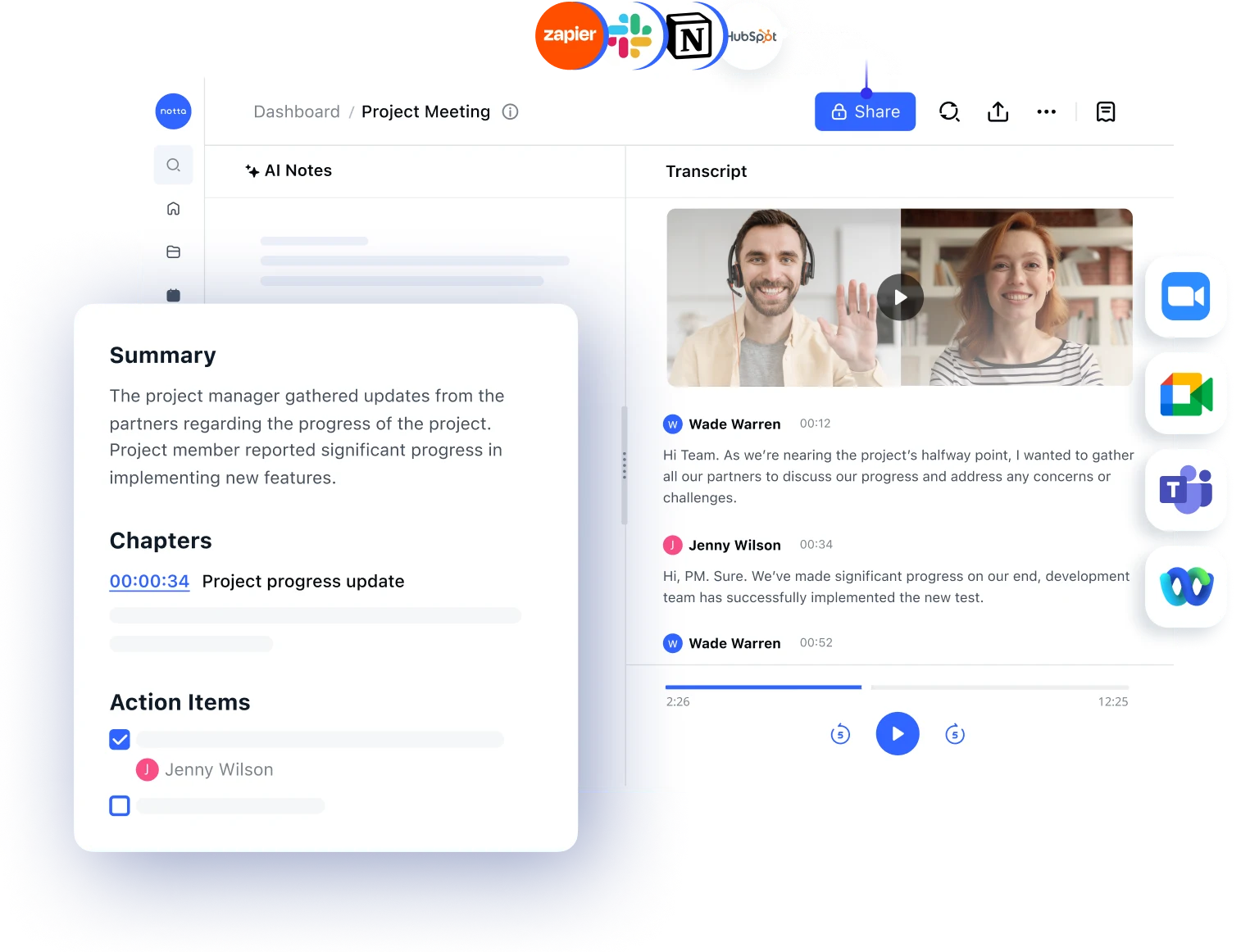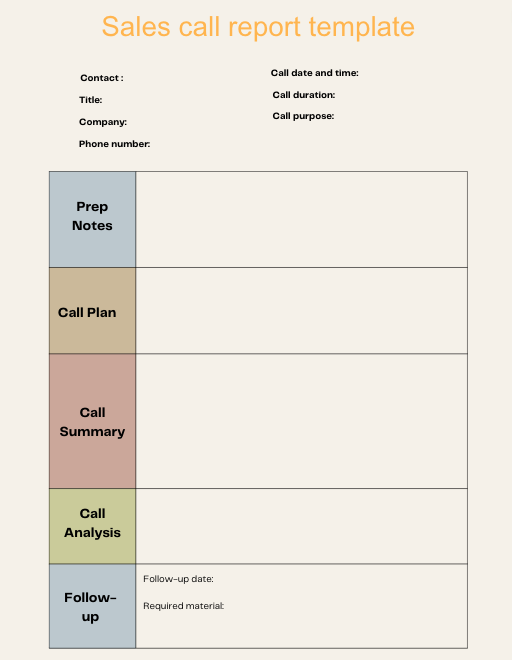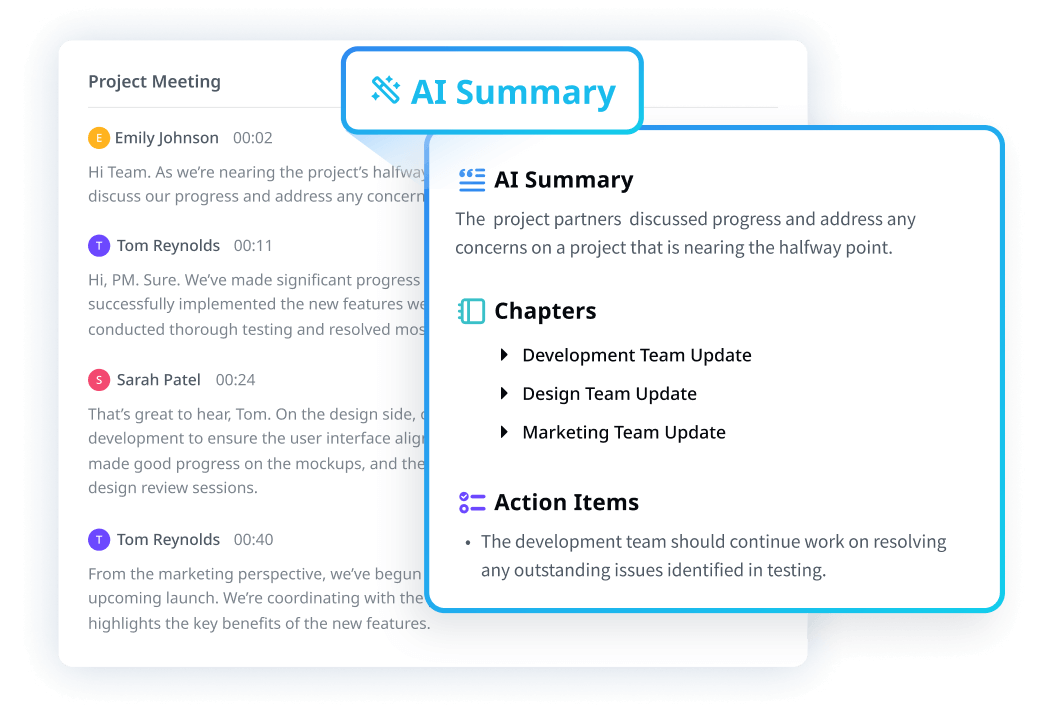Read more: How to Take Better Sales Notes for Your Call [+ Templates]

How to Create Sales Call Reports and Empower Your Team?
Record, transcribe and summarize conversations with one click.
After completing sales calls, it's a common practice for representatives to document the conversations - a process known as sales call reporting.
To the outsider, a sales call report can look like a simple documentation of what happened. However, to an intelligent sales leader, this wealth of data can bolster your sales strategy by providing actionable insights.
Sounds interesting?
In this post, we’ll walk through the importance of sales call reporting and how to create and use it to improve your existing systems.
What are sales call reports?
A sales call report is a written document that summarizes the engagement between a sales rep and a prospect. It reflects not only the salesperson's experience during the call but also their feedback on the conversation.
A report contains three key elements:
Technical data: the date and time of the call
Customer information: their name, company, and job title
Call details and notes: topics discussed, action items, and probable outcome
Every company has a format and length preference for their sales call reports. But the goal remains the same: to give the sales leaders a clear view of what is happening on the business front.
Why is sales call reporting important?
The importance of sales call reporting lies in the value a sales leader can derive from it. Although the time sales reps spend on filling this document is a concern, the data from the reports are a goldmine to any sales team looking to improve.
A good sales call report can:
1. Help identify the current market trends
During a call, prospects share a lot of information that, when used correctly, can help you predict the future trends of your industry. Some of these data points include:
The recurring challenges and pain points proposed by various clients.
Mentions about what your competitors are doing, their collaborations, and any emerging trends.
The length of the sales cycle - Short and consistent sales cycles may mean plenty of demand, allowing consumers to make their decisions faster. On the other hand, a long sales cycle may mean cautious decision-making by the prospect.
The average deal size and conversion rates to predict the changes in customer preference and the effectiveness of your sales strategies.
Also, pay attention to the client's details, such as their physical location, industry, and roles, to track the changes in your client demographic with time.
2. Measure a sales rep’s performance
Sales leaders can quickly analyze the individual performance of their sales teams using call reporting.
The data may reveal the speed of each sales rep in moving their prospects through the sales pipeline, how they do it, and their success rate, so you can compare to the average.
You can also identify the areas they need to work on and train your sales reps to close deals faster.
3. Provide an analysis of the overall user experience
What kind of experience do your prospects go through during their sales journey? Is it an easy and swift process, or does it have many complex processes?
A sales leader can use a call report to analyze the interactions between prospects and sales reps in the sales pipeline. This can help in gauging the user experience of your services.
4. Allows sales reps to take accountability
Every sales rep should be accountable for their actions in every sales call. A sales call report records who the responsible sales rep is, their adherence to timelines, their ability to handle objections, and close the sale.
Sales reps can use this report to reflect on their performance and improve. On the other hand, sales leaders can use this report to motivate, reward, or penalize sales reps based on their results.
7 essential elements to include in a sales call report
While sales call reports can vary in format, certain elements remain critical additions to this document.
1. Client information
This is the most essential component needed in a sales call report. It includes the prospect's name, email, phone number, company name, and title.
Contact information serves two fundamental purposes:
They provide a way to connect when necessary - (email and phone number)
They can help you identify your demographics - (company and title)
2. Date, time, and duration of the call
While seemingly trivial, this information is essential because it gives you insights into the best time to reach a lead and how effective the sales rep was using their time.
For instance, if a rep consistently has long but unsuccessful calls, it may signal poor value proposition communication and inadequate preparation. In this case, consider coaching them to polish their expressions.
3. Prep notes
This section is where sales reps highlight helpful information about the prospect from their research and their sales approach - a sign of how well the sales rep prepared for the call.
For example, they can include the problems the client is facing, an analysis of the point person, and anything that can help complete the sale.
4. Call purpose and plan
Another must-have element in sales call reports is the purpose of the call. For example, is your call meant to demonstrate your services or products, follow up on a client, or qualify a lead?
Throughout each of these calls, you need a structured call plan to guide you through the process and help you attain your goals.
5. Call summary
This section is undoubtedly the most important factor in a sales call report that provides an overview of the call: topics discussed, how it went, issues that arose, and the solutions provided, if any.
The information is a perfect reference for future calls to the same client. Remind your sales reps to only provide the most critical information from the conversation clearly and concisely so that any sales rep can take over a client and still understand what to do.

6. Call analysis
A comprehensive sales call report should include some feedback on the state of the call from the attending sales rep. Whatever to include in the analysis and how much of it is up to the sales rep. Here are some of the elements that can make up this section:
Account value: Estimate the value of the account, its growth potential, and any possible opportunities, such as the likelihood of repeat business.
Closing probability: Identify the percentage likelihood of closing the sale based on the current information.
Competitions: Provide a brief note on the competitors that your prospect mentions, including what makes them stand out.
Sales strategy: Give an overview of the sales strategy employed to win the lead. Did you focus more on relationship-building, consultation, or other tactics?
Sales leaders can use this data to learn about the sales reps' efforts and the sales stage, making it easy to assess their sales acumen.
7. The follow-up date & materials
Every sales call report should have a section that answers, 'What next?' This is not merely listing that you will make a follow-up call with a client, but also listing the follow-up date and time, the agreed next steps, and any required materials.
Using this as a reference during the follow-up increases the chances of the sales rep closing the deal.
With Notta, you can easily generate meeting minutes, turning spoken content into written records with 98.86% accuracy.
Sales call report template
Below is an example of what a sales call report might look like.

Pro tips to create and leverage sales call reports
With the above sales call report template, it's safe to say that you have everything necessary to create a custom report for your organization. However, we cannot dispute that most sales reps do not like writing these reports.
Here are some pro tips on how to create and leverage sales call reports more effectively.
1. Use Notta to simplify the process
Summarizing your sales call manually is a time-consuming process that can shift the attention of your sales reps from their most essential duties. Thanks to technology, you can now automate the process using AI. I would recommend the Notta AI meeting assistant for this task, and with good reasons.
Notta can record, transcribe, and summarize your sales calls intelligently. So you can get key insights and action items from the call summary to include in your report, saving you hours in manually reviewing your meeting notes.
Here is how to use Notta to create a sales report quickly:
Step 1: Record your sales meetings with Notta
Notta is compatible with all major video conferencing platforms, such as Zoom, Google Meet, Teams, Webex and in-person meetings.
Log in to Notta and invite the assistant to your meetings, and then it will automatically start recording and transcribing all conversions.
If you have already recorded the sales call, you can also import the recording to Notta to get a full transcript.
Step 2: Summarize the sales call with AI
With one click, Notta will automatically generate a meeting summary, including an overview, chapters, and action item.
The whole process happens in a few minutes, gaining you back value in time.

Step 3: Generate the report
You can edit and copy the summary into your sales call report.
What’s better, Notta allows you to clip and share the key moments from your sales calls, which serves as a complement to texts.
The tools also enhance your workflow by integrating with CRM systems such as Salesforce and Notion.
2. Finalize the report promptly
Add notes on your thoughts about the meeting when your memory of the call is fresh to make the report as comprehensive as possible.
Limit this only to details relevant to the sales call that may be helpful to the sales rep making the follow-up. For example, if the prospect hesitates about the price, mention this in the analysis. This will act as a guide on how to approach the prospect during the follow-up.
3. Review the report before follow-up
If the overall goal is to increase the percentage of deals closed by your sales reps, institutionalize the idea of reviewing reports before making any follow-up.
So they will take the process more seriously and put more effort into ensuring the sales report includes critical information that can affect the sale. At the same time, you will improve the sales process by speeding up the sales cycle.
4. Make sure the team understands the reason behind the tracking
After teaching your sales reps how to prepare a sales call report, help them understand why. One major mistake some organizations make is using these reports to micro-manage sales reps. This misconstrued use is part of why many sales reps do not take the initiative to create a call report.
You can avoid this by clearly showing your sales reps how the report fits into your overall sales strategy and its effect.
Notta AI meeting assistant records, transcribes, and summarizes meetings and calls so everyone can stay engaged without missing important details.
Incorporate sales call reporting into your sales strategy
A sales call report is one of the best sales enablement tools to document and analyze client conversations. It can allow your sales team to take accountability for their actions, identify the current trends in the market, and give you insights that can improve your closing percentage.
If the time to create this report is still a constraint, take advantage of Notta to record, transcribe, and analyze your sales calls within minutes. Then, copy the summary and action points and include them in your report.